Click on images to enlarge
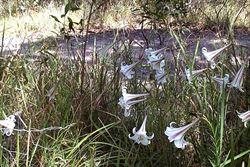
infestation (Photo: Jackie Miles and Max Campbell)
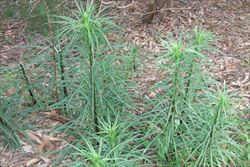
habit prior to flowering (Photo: Kerinne Harvey)
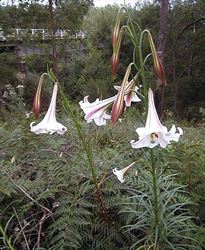
habit in flower (Photo: Jackie Miles and Max Campbell)
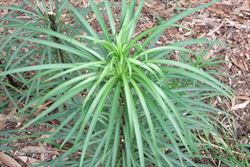
long and narrow leaves (Photo: Kerinne Harvey)
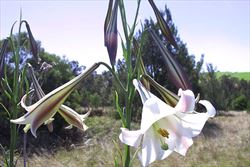
flowers (Photo: Jackie Miles and Max Campbell)
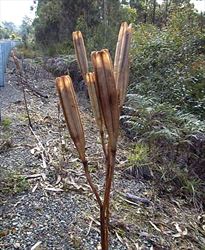
mature fruit (Photo: Jackie Miles and Max Campbell)
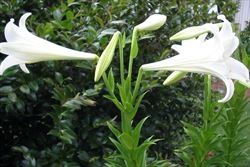
November lily (Lilium longiflorum) with shorter and broader leaves, and without a purplish tinge on its flowers (Photo: Sheldon Navie)
Scientific Name
Lilium formosanum Wallace
Synonyms
Lilium longiflorum Thunb. var. formosanum BakerLilium philippinense Baker var. formosanum (Wallace) E.H. WilsonLilium yoshidai Leichtlin
Family
Liliaceae
Common Names
Formosa lily, Formosan lily, lily, St Joseph's lily, Taiwan lily, tiger lily, trumpet lily
Origin
Native to Taiwan.
Cultivation
Widely cultivated as a garden ornamental, particularly in the temperate regions of Australia.
Naturalised Distribution
Widely naturalised in eastern Australia (i.e. in south-eastern Queensland, in the coastal and sub-coastal districts of eastern New South Wales and in southern Victoria). Also naturalised on Lord Howe Island and Norfolk Island.
Habitat
A weed of wetter sub-tropical and temperate regions. This escaped garden plant grows along roadsides and in bushland, grasslands, disturbed sites and waste areas.
Habit
An upright (i.e. erect) herbaceous plant with long-lived (i.e. perennial) underground bulbs producing short-lived (i.e. annual) shoots usually growing 1-1.5 m tall, but occasionally reaching up to 2 m in height.
Distinguishing Features
- an upright herbaceous plant with unbranched stems growing up to 2 m tall.
- its elongated and narrow leaves (7.5-20 cm long and 5-10 mm wide) are stalkless and hairless.
- its very showy funnel-shaped flowers (12-20 cm long) have six large 'petals'.
- these mostly white flowers are usually flushed with mauve or reddish-purple on the outside.
- its large capsules (5-9 cm long and 1-2 cm wide) are cylindrical in shape.
Stems and Leaves
The upright (i.e. erect) stems are unbranched and mostly hairless (i.e. glabrous). They are mostly dark green in colour, but are often somewhat purplish-brown towards the base.
The alternately arranged leaves are stalkless (i.e. sessile) and widely spaced along the stems. These leaves (7.5-20 cm long and 5-10 mm wide) are elongated (i.e. lanceolate) or linear in shape and generally become smaller towards the top of the stems. They are hairless (i.e. glabrous) with entire margins and pointed tips (i.e. acute apices).
Flowers and Fruit
The large flowers are arranged in clusters of one to ten at the top of the stems and are borne on stalks (i.e. pedicels) 5-15 cm long. These showy flowers (12-20 cm long) are funnel-shaped (i.e. tubular) and mostly white in colour, but their outsides are usually flushed with a little mauve or reddish-purple. They have six 'petals' (i.e. perianth segments) and six large stamens (about 10 cm long) topped with yellow or purplish anthers (8-10 mm long). They also have a large ovary (3-3.5 cm long) and a long style (7-8 cm long) topped with a three-lobed stigma that is whitish to greenish in colour. Flowering occurs during summer and autumn (i.e. from January to April).
The large capsules (5-9 cm long and 1-2 cm wide) are cylindrical in shape and contain numerous winged seeds.
Reproduction and Dispersal
This species reproduces by seed and also vegetatively by bulbs. The winged seeds are dispersed by wind and water, and the seeds and bulbs may be spread in dumped garden waste.
Environmental Impact
Formosan lily (Lilium formosanum) is regarded as a major environmental weed on Lord Howe Island and Norfolk Island, and as an environmental weed in Victoria, New South Wales and Queensland.
Legislation
This species is declared under legislation in the following states and territories:
- New South Wales: Class 4 - a locally controlled weed. The growth and spread of this species must be controlled according to the measures specified in a management plan published by the local control authority and the plant may not be sold, propagated or knowingly distributed (on Lord Howe Island only).
- Western Australia: Unassessed - this species is declared in other states or territories and is prohibited until assessed via a weed risk assessment (throughout the entire state).
Management
For information on the management of this species see the following resources:
- the Formosan or Taiwan lily page on the South Coast Weeds website at http://www.esc.nsw.gov.au/Weeds/index.asp.
Similar Species
Formosan lily (Lilium formosanum) is a very distinctive plant and is rarely confused with other naturalised species. However, it is very similar to the commonly cultivated garden plant known as November lily (Lilium longiflorum). These two species can be distinguished by the following differences:
- Formosan lily (Lilium formosanum) has very narrow leaves (5-10 mm wide) and flowers that are mostly white in colour, but usually flushed with mauve or reddish-purple on the outside (rarely pure white).
- November lily (Lilium longiflorum) has relatively narrow leaves (10-30 mm wide) and flowers that are pure white in colour.

